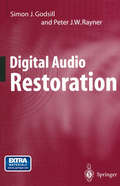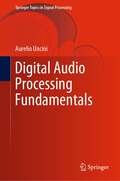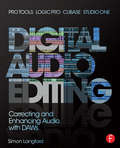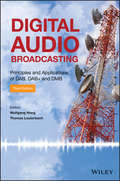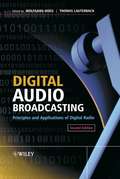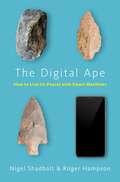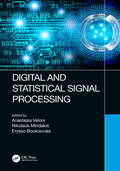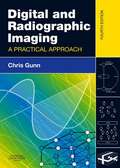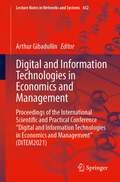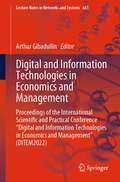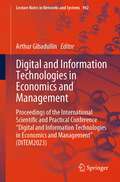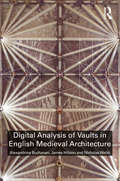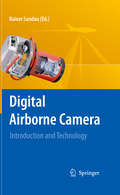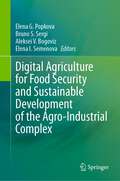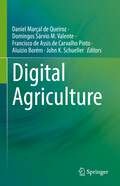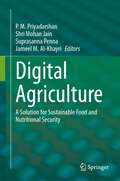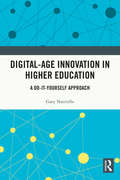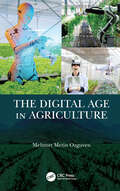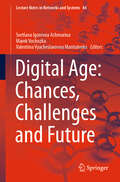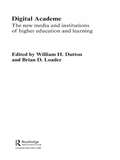- Table View
- List View
Digital Audio Restoration
by Simon J. Godsill Peter J.W. RaynerThe application of digital signal processing (DSP) to problems in audio has been an area of growing importance since the pioneering DSP work of the 1960s and 70s. In the 1980s, DSP micro-chips became sufficiently powerful to handle the complex processing operations required for sound restoration in real-time, or close to real-time. This led to the first commer cially available restoration systems, with companies such as CEDAR Audio Ltd. in the UK and Sonic Solutions in the US selling dedicated systems world-wide to recording studios, broadcasting companies, media archives and film studios. Vast amounts of important audio material, ranging from historic recordings of the last century to relatively recent recordings on analogue or even digital tape media, were noise-reduced and re-released on CD for the increasingly quality-conscious music enthusiast. Indeed, the first restorations were a revelation in that clicks, crackles and hiss could for the first time be almost completely eliminated from recordings which might otherwise be un-releasable in CD format. Until recently, however, digital audio processing has required high-powered computational engines which were only available to large institutions who could afford to use the sophisticated digital remastering technology. With the advent of compact disc and other digital audio formats, followed by the increased accessibility of home computing, digital audio processing is now available to anyone who owns a PC with sound card, and will be of increasing importance, in association with digital video, as the multimedia revolution continues into the next millennium.
Digital Audio Processing Fundamentals (Springer Topics in Signal Processing #21)
by Aurelio UnciniThe book provides an accessible overview of audio signal processing, and enables readers to design and write algorithms for the analysis, synthesis, and manipulation of musical and acoustic signals for any programming language. It provides an overview of highly interdisciplinary topics developed in a simple but rigorous way, and described in a unified and formal language which focuses on determining discrete-time audio signal models. Readers can find within a self-contained volume basic topics ranging over different disciplines: mechanical acoustics, physical systems and linear and nonlinear models, with lumped and distributed parameters; described and developed with the same level of mathematical formalism, easy to understand and oriented to the development of algorithms. Topics include the fundamental concepts of acoustic mechanics and vibration; the design of filters and equalizers for sound signals, the so-called audio effects, abstract methods of sound synthesis, and finally, methods of synthesis by physical modeling.
Digital Audio Editing: Correcting and Enhancing Audio in Pro Tools, Logic Pro, Cubase, and Studio One
by Simon LangfordWhether you’re comping a vocal track, restoring an old recording, working with dialogue or sound effects for film, or imposing your own vision with mash-ups or remixes, audio editing is a key skill to successful sound production. Digital Audio Editing gives you the techniques, from the simplest corrective editing like cutting, copying, and pasting to more complex creative editing, such as beat mapping and time-stretching. You’ll be able to avoid unnatural-sounding pitch correction and understand the potential pitfalls you face when restoring classic tracks. Author Simon Langford invites you to see editing with his wide-angle view, putting this skill into a broad context that will inform your choices even as you more skillfully manipulate sound. Focusing on techniques applicable to any digital audio workstation, it includes break-outs giving specific keystrokes and instruction in Avid’s Pro Tools, Apple’s Logic Pro, Steinberg’s Cubase, and PreSonus’s Studio One. The companion websites includes tutorials in all four software packages to help you immediately apply the broad skills from the book.
Digital Audio Editing: Correcting and Enhancing Audio in Pro Tools, Logic Pro, Cubase, and Studio One
by Simon LangfordWhether you’re comping a vocal track, restoring an old recording, working with dialogue or sound effects for film, or imposing your own vision with mash-ups or remixes, audio editing is a key skill to successful sound production. Digital Audio Editing gives you the techniques, from the simplest corrective editing like cutting, copying, and pasting to more complex creative editing, such as beat mapping and time-stretching. You’ll be able to avoid unnatural-sounding pitch correction and understand the potential pitfalls you face when restoring classic tracks. Author Simon Langford invites you to see editing with his wide-angle view, putting this skill into a broad context that will inform your choices even as you more skillfully manipulate sound. Focusing on techniques applicable to any digital audio workstation, it includes break-outs giving specific keystrokes and instruction in Avid’s Pro Tools, Apple’s Logic Pro, Steinberg’s Cubase, and PreSonus’s Studio One. The companion websites includes tutorials in all four software packages to help you immediately apply the broad skills from the book.
Digital Audio Broadcasting: Principles and Applications of DAB, DAB + and DMB
by Wolfgang Hoeg Thomas LauterbachDigital Audio Broadcasting revised with the latest standards and updates of all new developments The new digital broadcast system family is very different from existing conventional broadcast systems. It is standardised in a large number of documents (from ITU-R, ISO/IEC, ETSI, EBU, and others) which are often difficult to read. This book offers a comprehensive and fully updated overview of Digital Audio Broadcasting (DAB, DAB+) and Digital Multimedia Broadcasting (DMB), and related services and applications. Furthermore, the authors continue to build upon the topics of the previous editions, including audio coding, data services, receiver techniques, frequencies, and many others. There are several new sections in the book, which would be otherwise difficult to locate from various sources. Key Features: The contents have been significantly updated from the second edition, including up-to-date coverage of the latest standards Contains a new chapter on Digital Multimedia Broadcasting “Must-have” handbook for engineers, developers and other professionals in the field This book will be of interest to planning and system engineers, developers for professional and domestic equipment manufacturers, service providers, postgraduate students and lecturers in communications technology. Broadcasting engineers in related fields will also find this book insightful.
Digital Audio Broadcasting: Principles and Applications of Digital Radio
by Wolfgang Hoeg Thomas LauterbachNow the standardisation work of DAB (Digital Audio Broadcasting) system is finished many broadcast organisations, network providers and receiver manufacturers in European countries and outside of Europe (for example Canada and the Far East) will be installing DAB broadcast services as pilot projects or public services. In addition some value added services (data and video services) are under development or have already started as pilot projects. The new digital broadcast system DAB distinguishes itself from existing conventional broadcast systems, and the various new international standards and related documents (from ITU-R, ISO/IEC, ETSI, EBU, EUREKA147, and others) are not readily available and are difficult to read for users. Therefore it is essential that a well structured technical handbook should be available. The Second Edition of Digital Audio Broadcasting has been fully updated with new sections and chapters added to reflect all the latest developments and advances. Digital Audio Broadcasting: Provides a fully updated comprehensive overview of DAB Covers international standards, applications and other technical issues Combines the expertise of leading researchers in the field of DAB Now covers such new areas as: IP-Tunneling via DAB; Electronic Programme Guide for DAB; and Metadata A comprehensive overview of DAB specifically written for planning and system engineers, developers for professional and domestic equipment manufacturers, service providers, as well as postgraduate students and lecturers in communications technology.
The Digital Ape: How to Live (in Peace) with Smart Machines
by Roger Hampson Sir Nigel ShadboltThe smart-machines revolution is reshaping our lives and our societies. Here, Sir Nigel Shadbolt, one of the world's leading authorities on artificial intelligence, and Roger Hampson dispel terror, confusion, and misconception. We are not about to be elbowed aside by a rebel army of super-intelligent robots of our own creation. We were using tools before we became Homo sapiens, and will continue to build and master them, no matter how complicated they become. How we exercise that control--in our private lives, in employment, in politics--and make the best of the wonderful opportunities, will determine our collective future well-being. Chapter by chapter, The Digital Ape outline how our choices and the use and adaptation of the tools we've created can lead to opportunities for the environment (both built and natural), health, and our security. Shadbolt and Hampson are uniquely well-suited to draw on historical precedent and technical know-how to offer a vision of the future that is exciting, rather than nerve-wracking, to contemplate.
The Digital Ape: How to Live (in Peace) with Smart Machines
by Sir Nigel Shadbolt Roger HampsonThe smart-machines revolution is reshaping our lives and our societies. Here, Sir Nigel Shadbolt, one of the world's leading authorities on artificial intelligence, and Roger Hampson dispel terror, confusion, and misconception. We are not about to be elbowed aside by a rebel army of super-intelligent robots of our own creation. We were using tools before we became Homo sapiens, and will continue to build and master them, no matter how complicated they become. How we exercise that control--in our private lives, in employment, in politics--and make the best of the wonderful opportunities, will determine our collective future well-being. Chapter by chapter, The Digital Ape outline how our choices and the use and adaptation of the tools we've created can lead to opportunities for the environment (both built and natural), health, and our security. Shadbolt and Hampson are uniquely well-suited to draw on historical precedent and technical know-how to offer a vision of the future that is exciting, rather than nerve-wracking, to contemplate.
Digital and Statistical Signal Processing
by Anastasia Veloni Nikolaos Miridakis Erysso BoukouvalaNowadays, many aspects of electrical and electronic engineering are essentially applications of DSP. This is due to the focus on processing information in the form of digital signals, using certain DSP hardware designed to execute software. Fundamental topics in digital signal processing are introduced with theory, analytical tables, and applications with simulation tools. The book provides a collection of solved problems on digital signal processing and statistical signal processing. The solutions are based directly on the math-formulas given in extensive tables throughout the book, so the reader can solve practical problems on signal processing quickly and efficiently. FEATURES Explains how applications of DSP can be implemented in certain programming environments designed for real time systems, ex. biomedical signal analysis and medical image processing. Pairs theory with basic concepts and supporting analytical tables. Includes an extensive collection of solved problems throughout the text. Fosters the ability to solve practical problems on signal processing without focusing on extended theory. Covers the modeling process and addresses broader fundamental issues.
Digital and Radiographic Imaging E-Book: A Practical Approach
by Chris GunnThis book covers all the existing imaging modalities currently in use in imaging departments, providing a sound basis for understanding how individual systems work. It is designed to be accessible to students without minimising the content. Although conventional imaging is being phased out, it still exists in certain areas, e.g. dental surgeries, and therefore is reduced in size and placed in an Appendix.The text has been restructured in list form to increase clarity and aid studyPedagogic features include an introduction and summary for each chapterGlossaries of imaging terms and computer buzz words, and a key to commonly used abbreviations are includedNew edition is completely rewritten: Digital imaging is main focusCT, ultrasound, MRI and NMR imaging added'Conventional' imaging retained as an AppendixText simplified, and block diagrams, flow charts and tables added to increase accessibility of content
Digital and Information Technologies in Economics and Management: Proceedings of the International Scientific and Practical Conference "Digital and Information Technologies in Economics and Management" (DITEM2021) (Lecture Notes in Networks and Systems #432)
by Arthur GibadullinThis book addresses the issues of information, digital and intellectual technologies in economics and management. The International Scientific and Practical Conference "Digital and Information Technologies in Economics and Management" (DITEM2021) was held on November 2, 2021, on the Microsoft Teams platform due to COVID-19. A distinctive feature of the book is that it presented reports of authors from Italy, South Korea, Poland, Armenia, Republic of Belarus and the Russian Federation. Researchers from different countries presented the process of transition of economic activities to the information and digital path of development and presented the main directions and developments that can improve the efficiency and development of the economy and management. The book may be useful to state and regional authorities, international and supranational organizations, the scientific and professional community.
Digital and Information Technologies in Economics and Management: Proceedings of the International Scientific and Practical Conference "Digital and Information Technologies in Economics and Management" (DITEM2022) (Lecture Notes in Networks and Systems #683)
by Arthur GibadullinThis book covers the II International Scientific and Practical Conference "Digital and Information Technologies in Economics and Management" (DITEM2022), which was held on November 21–23, 2022. The conference addressed issues of information, digital and intellectual technologies in economics and management. A distinctive feature of the conference is that it presented reports of authors from China, Saudi Arabia, Tunisia, Uzbekistan, Tajikistan, Angola, Kazakhstan, India and Russia. Researchers from different countries presented the process of transition of economic activities to the information and digital path of development and presented the main directions and developments that can improve the efficiency and development of the economy and management. The materials of the conference may be useful to state and regional authorities, international and supranational organizations, the scientific and professional community.
Digital and Information Technologies in Economics and Management: Proceedings of the International Scientific and Practical Conference "Digital and Information Technologies in Economics and Management" (DITEM2023) (Lecture Notes in Networks and Systems #942)
by Arthur GibadullinThis book covers the III International Scientific and Practical Conference "Digital and Information Technologies in Economics and Management" (DITEM2023) which was held on November 21–23, 2023. The conference addressed issues of networks and systems related to the use of information technologies in economics and management of various sectors. A distinctive feature of the conference is that it featured presentations by authors from China, Bulgaria, Uzbekistan, Oman, Kazakhstan and Russia. Researchers from different countries presented the process of transition to new information technologies of various network and system structures and sectors. The conference made it possible to develop new scientific recommendations on the use of information, computer, digital and intellectual technologies and networks in industry and fields of activity that can be useful to state and regional authorities, international and supranational organizations, the scientific and professional community.
Digital Analysis of Vaults in English Medieval Architecture
by Alexandrina Buchanan James Hillson Nicholas WebbMedieval churches are one of the most remarkable creative and technical achievements in architectural history. The complex vaults spanning their vast interiors have fascinated both visitors and worshippers alike for over 900 years, prompting many to ask: ‘How did they do that?’ Yet very few original texts or drawings survive to explain the processes behind their design or construction. This book presents a ground-breaking new approach for analysing medieval vaulting using advanced digital technologies. Focusing on the intricately patterned rib vaulting of thirteenth and fourteenth century England, the authors re-examine a series of key sites within the history of Romanesque and Gothic Architecture, using extensive digital surveys to examine the geometries of the vaults and provide new insights into the design and construction practices of medieval masons. From the simple surfaces of eleventh-century groin vaults to the gravity-defying pendant vaults of the sixteenth century, they explore a wide range of questions including: How were medieval vaults conceived and constructed? How were ideas transferred between sites? What factors led to innovations? How can digital methods be used to enhance our understanding of medieval architectural design? Featuring over 200 high quality illustrations that bring the material and the methods used to life, Digital Analysis of Vaults in English Medieval Architecture is ideal reading for students, researchers and anyone with an interest in medieval architecture, construction history, architectural history and design, medieval geometry or digital heritage.
Digital Analysis of Vaults in English Medieval Architecture
by Alexandrina Buchanan James Hillson Nicholas WebbMedieval churches are one of the most remarkable creative and technical achievements in architectural history. The complex vaults spanning their vast interiors have fascinated both visitors and worshippers alike for over 900 years, prompting many to ask: ‘How did they do that?’ Yet very few original texts or drawings survive to explain the processes behind their design or construction. This book presents a ground-breaking new approach for analysing medieval vaulting using advanced digital technologies. Focusing on the intricately patterned rib vaulting of thirteenth and fourteenth century England, the authors re-examine a series of key sites within the history of Romanesque and Gothic Architecture, using extensive digital surveys to examine the geometries of the vaults and provide new insights into the design and construction practices of medieval masons. From the simple surfaces of eleventh-century groin vaults to the gravity-defying pendant vaults of the sixteenth century, they explore a wide range of questions including: How were medieval vaults conceived and constructed? How were ideas transferred between sites? What factors led to innovations? How can digital methods be used to enhance our understanding of medieval architectural design? Featuring over 200 high quality illustrations that bring the material and the methods used to life, Digital Analysis of Vaults in English Medieval Architecture is ideal reading for students, researchers and anyone with an interest in medieval architecture, construction history, architectural history and design, medieval geometry or digital heritage.
Digital Airborne Camera: Introduction and Technology
by Rainer SandauDigital airborne cameras are now penetrating the fields of photogrammetry and remote sensing. Due to the last decade’s results in research and development in the fields of for instance detector technology, computing power, memory capacity position and orientation measurement it is now possible to generate with this new generation of airborne cameras different sets of geometric and spectral data with high geometric and radiometric resolutions within a single flight. This is a decisive advantage as compared to film based airborne cameras. The linear characteristic of the opto-electronic converters is the basis for the transition from an imaging camera to an images generating measuring instrument. Because of the direct digital processing chain from the airborne camera to the data products there is no need for the processes of chemical film development and digitising the film information. Failure sources as well as investments and staff costs are avoided. But the effective use of this new technology requires the knowledge of the features of the image and information generation, its possibilities and its restrictions. This book describes all components of a digital airborne camera from the object to be imaged to the mass memory device. So the image quality influencing processes in nature are described, as for instance the reflection of the electromagnetic sun spectrum at the objects to be imaged and the influence of the atmosphere. Also, the essential features of the new digital sensor system, their characteristics and parameters, are addressed and put into the system context. The complexity of the cooperation of all camera components, as for instance optics, filters, detector elements, analogue and digital electronics, software and so forth, becomes transparent. The book includes also the description of example systems.
Digital Agriculture for Food Security and Sustainable Development of the Agro-Industrial Complex
by Elena G. Popkova Bruno S. Sergi Aleksei V. Bogoviz Elena I. SemenovaThe book discusses the best international practices in digital agriculture. The book aims to form systemic scientific and methodological support and develop comprehensive applied solutions to unlock the potential of sustainable development of digital agriculture for food security. The book’s contribution to the literature lies in its comprehensive treatment of public and corporate management of farms representing digital agriculture. The research novelty is associated with the systemic disclosure of economic, legal, and technological issues in the development of digital agriculture. Thus, the book provides a solid foundation for integrating food security interests into farming practices. The first part of the book reflects the economic, legal, and technological support of quality management and sustainable development in digital agribusiness based on the best international practices. The second part focuses on Russian and international agricultural policies for food security. The book is intended for members of the academic community who will find promising solutions to current problems of food security through the development of digital agriculture. The book will also be of interest to farmers and representatives of the state regulation of the agricultural economy. In this book, they will find practical recommendations for improving government and corporate management of food security through the development of digital agriculture.
Digital Agriculture
by Daniel Marçal de Queiroz Domingos Sárvio M. Valente Francisco de Assis de Carvalho Pinto Aluízio Borém John K. SchuellerThis textbook addresses the most recent advances and main digital technologies used in farming. The reader will be able to understand the main concepts and techniques currently used to efficiently manage agricultural production systems. The book covers topics in a general and intuitive way, with examples and good illustrations.
Digital Agriculture: A Solution for Sustainable Food and Nutritional Security
by P. M. Priyadarshan Shri Mohan Jain Suprasanna Penna Jameel M. Al-KhayriThe world population is increasing while arable land is decreasing at an alarming rate. About one-quarter of arable land is degraded and needs significant restoration before it can sustain crops again. By 2030, the water supply will fall 40% short of meeting global demand. Moreover, looming climate change poses additional challenge to increasing food production to feed 10 billion people by 2050. Current major agricultural systems are on a largely unsustainable trajectory because of their contributions to greenhouse gas emissions, water pollution, and biodiversity loss.For these reasons, innovative technologies are being introduced in modern agriculture to sustain food production. They include digital and geospatial technologies to manage soil, climate and plant genetic resources. With the development of tools and sensors integrated into the internet of things (IoT) environment, physically collected information is converted into computer-readable language. Digital innovations thus allow real-time analysis, machine learning, and artificial intelligence (AI) that manage massive amount of data, also known as big data. Accordingly, digital agriculture affords greater potential for sustainable farming and economic benefits. This book summarizes the latest advances in AI-integration of agriculture practices. Specific focus includes but not limited to, big data, yield mapping, pests management, and optimal fertigation. As such, it presents a forward-looking approach to meet multiple UN Sustainable Development Goals, specifically, SDG 2, 6, 13 and 15.
Digital-Age Innovation in Higher Education: A Do-It-Yourself Approach
by Gary NatrielloDigital-Age Innovation in Higher Education recounts the creation, development, and growth of an innovation unit within a major university. This single case study follows the development of the EdLab at the Gottesman Libraries of Teachers College, Columbia University, which was charged with developing new services and products at a time when digital technologies were markedly beginning to impact the sector. The major steps taken – recruiting staff in key skill areas, developing projects, collaborating across organizational lines, securing resources, delivering new services, and more – are covered in detail, illustrating the opportunities and challenges presented by innovation mandates in long-established organizations with stable operations and traditional academic values and practices.
Digital-Age Innovation in Higher Education: A Do-It-Yourself Approach
by Gary NatrielloDigital-Age Innovation in Higher Education recounts the creation, development, and growth of an innovation unit within a major university. This single case study follows the development of the EdLab at the Gottesman Libraries of Teachers College, Columbia University, which was charged with developing new services and products at a time when digital technologies were markedly beginning to impact the sector. The major steps taken – recruiting staff in key skill areas, developing projects, collaborating across organizational lines, securing resources, delivering new services, and more – are covered in detail, illustrating the opportunities and challenges presented by innovation mandates in long-established organizations with stable operations and traditional academic values and practices.
The Digital Age in Agriculture
by Mehmet Metin OzguvenThe Digital Age in Agriculture presents information related to the digital age in the agriculture sector. Agriculture is an essential activity for the continuity of life, yet is very labor-intensive and faces a wide variety of challenges. In the struggle against these difficulties, the superior features offered by technology provide important benefits. These technologies require expertise in various technical disciplines, and The Digital Age in Agriculture provides information to readers allowing them to make more informed decisions and giving them the opportunity to improve agricultural productivity. Written by Mehmet Metin Özgüven, an expert who has conducted field studies and with a working technical knowledge of various topics pertaining to the agriculture age, this book covers many subjects important to the age of digital agriculture, including precision agriculture and livestock farming, using agricultural robots and unmanned arial vehicles in agriculture practices, and image processing and machine vision. It is an essential read for researchers, agriculture sector workers, and agricultural engineers.
The Digital Age in Agriculture
by Mehmet Metin OzguvenThe Digital Age in Agriculture presents information related to the digital age in the agriculture sector. Agriculture is an essential activity for the continuity of life, yet is very labor-intensive and faces a wide variety of challenges. In the struggle against these difficulties, the superior features offered by technology provide important benefits. These technologies require expertise in various technical disciplines, and The Digital Age in Agriculture provides information to readers allowing them to make more informed decisions and giving them the opportunity to improve agricultural productivity. Written by Mehmet Metin Özgüven, an expert who has conducted field studies and with a working technical knowledge of various topics pertaining to the agriculture age, this book covers many subjects important to the age of digital agriculture, including precision agriculture and livestock farming, using agricultural robots and unmanned arial vehicles in agriculture practices, and image processing and machine vision. It is an essential read for researchers, agriculture sector workers, and agricultural engineers.
Digital Age: Chances, Challenges and Future (Lecture Notes in Networks and Systems #84)
by Svetlana Igorevna Ashmarina Marek Vochozka Valentina Vyacheslavovna MantulenkoThis proceedings book presents the outcomes of the VII International Scientific Conference “Digital Transformation of the Economy: Challenges, Trends, New Opportunities”, which took place in Samara, Russian Federation, on April 26–27, 2019. Organized by the Samara State University of Economics, the conference chiefly focused on digital economy issues, such as theoretical preconditions for the development of economic systems in the digital age and specific practical issues related to real-world business practice. Consisting of six chapters corresponding to the thematic areas of the conference, and written by scientists and practitioners from different regions of Russia, Kazakhstan, the Czech Republic and Germany, the book offers answers to the most pressing questions for today’s business community: - How is our world changing under the influence of digital technology? - Is sustainable economic development a myth or reality in the context of digitalization? - What threats and opportunities does digitalization bring? - What are realities and prospects of digitalization in the context of business practice? - How do we create a digital infrastructure for the economy? - How should the legal environment of the economy be transformed in the context of digitalization? The conclusions and recommendations presented are not recipes for solving the existing economic problems, but instead are intended for use in further research on transformation processes in the economy and in the development of state economic policies in various countries and regions.
Digital Academe: New Media in Higher Education and Learning
by William H. Dutton Brian D. LoaderThis book responds to an ever-increasing call from educators, policy makers, journalists, parents and the public at large for analysis that cuts through the hype surrounding the information revolution to address key issues associated with new media in higher education and learning. This collection is of value to those who are seeking a critical, non-commercial exposition of both the enormous opportunities and challenges for higher education that are tied to the use of new information and communication technologies (ICTs) in the development of distance education and distributed learning.The chapters are written by leading exponents, practitioners and researchers from a variety of disciplinary perspectives and the collection as a whole spans national boundaries and reaches beyond the research community to relate to issues of policy and practice.
